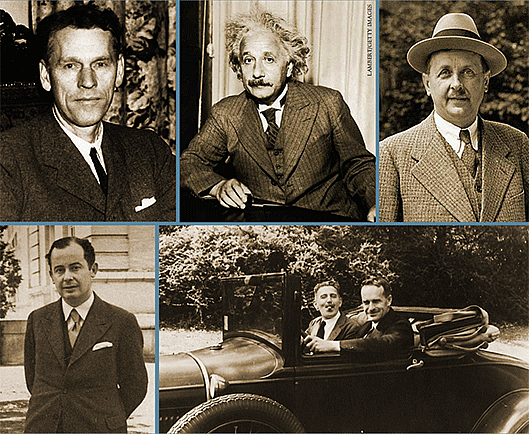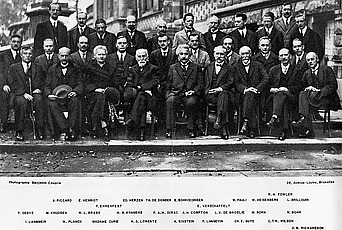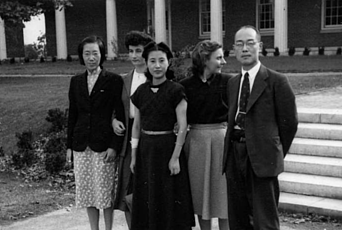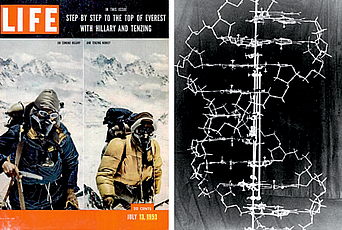Institute for Advanced Study: Opening Day, October 2, 1933

Seventy-five years ago, after nearly four years of discussion and planning, the Institute for Advanced Study opened on Monday, October 2, 1933. The Director, Abraham Flexner, called together the Faculty of its only school, the School of Mathematics. Present for the meeting were Oswald Veblen, James Alexander, and John von Neumann. The Institute’s other two Professors, Albert Einstein and Hermann Weyl, were in Europe and would arrive later in the month. This article recounts how these individuals became the first Faculty members.
From the Institute’s conception, Flexner’s overarching ambition was to elevate research in the United States. His inspiration was Daniel Coit Gilman, who had recruited mathematician J. J. Sylvester, classicist Basil Gildersleeve, and physicist Henry Rowland along with three professors in other fields for the opening of Johns Hopkins. Flexner wrote to his brother Simon in June 1930: “I realize fully that everything depends, as it depended in Baltimore in 1876, on bringing together a group of persons. If I can get them it will succeed—if I can’t, it won’t.” As Gilman before him, Flexner was open-minded as to subjects. He never intended, however, for the first five Faculty members to belong to the same school.
In his search for personnel, Flexner traveled to the intellectual centers of the United States and Europe. He sought to identify the best American scholars who had already achieved world-class standing. By early 1931, the list of candidates had narrowed to Chicago economist Jacob Viner and Harvard mathematician George D. Birkhoff. In April, Flexner decided that a Birkhoff-led School of Mathematics was the place to start. A number of factors entered into the decision, not the least of which was Flexner’s personal assessment of the two scholars. Flexner himself was completely ignorant in mathematics. From the experts he had learned that G. H. Hardy at Oxford and Hermann Weyl at Göttingen were the world’s foremost mathematicians, with Birkhoff the best American. The leading American departments were at Harvard and Princeton, but both trailed the finest European institutions. Flexner’s plan was to locate the Institute in Princeton where Birkhoff, together with the Princeton University mathematicians, would establish an American center for the subject. To succeed he would have to lure Birkhoff from Harvard and dissuade the founders, Louis Bamberger and his sister Caroline Fuld, from their desire for a venue in their hometown of Newark. Flexner set out toprepare the groundwork with the Trustees, confident that both objectives were achievable.
At this point Flexner’s personnel scheme for mathematics consisted of Birkhoff, annual visits by Europeanluminaries, promising junior American mathematicians on multi-year appointments, and graduate students. A December 1931 consultation with Princeton University professor Oswald Veblen prompted Flexner to rethink his plans. Just two months earlier Veblen had received a letter from Hermann Weyl indicating that the great German mathematician might be persuaded to move to Princeton. Still awaiting identification of the ideal American economist, Flexner began to contemplate an expanded mathematics Faculty. It was the beginning of Veblen’s consequential role in shaping the Institute.
Meanwhile, Flexner was still trying to finesse the delicate issue of locating in Princeton. Rather than advancing on offers to Weyl and Birkhoff, early in 1932 he traveled to the California Institute of Technology where Einstein was temporarily in residence. Flexner pitched his Institute vision to Einstein, and came away convinced that the physicist was enthusiastic about joining the Faculty. To bring Birkhoff, Weyl, and Einstein to Princeton would elevate the New Jersey town’s standing in mathematics to the highest level in the world. Flexner obtained the Bambergers’ approval to approach the three men with attractive salary offers.
The next move was a letter to Weyl, expressing interest in having him join the Faculty and proposing to discuss the matter in Europe. Flexner had already scheduled a summer follow- up with Einstein at Oxford. The first formal offer then went to Birkhoff at the end of February. Birkhoff weighed the scholarly opportunities and financial advantages with his longstanding successful career at Harvard. Twice he accepted, only to reconsider.
Birkhoff’s final decision to remain in Cambridge was a huge setback for Flexner, who was determined to have Americans lead the Institute. Two years of searching had turned up Birkhoff as the one perfect Faculty candidate. As Flexner sailed to Europe for meetings with Einstein and Weyl, he pondered a new American name, Oswald Veblen.
Veblen had made important contributions to the foundations of projective geometry and algebraic topology. More than any American mathematician, he shared Flexner’s vision for promoting research in the United States. Over the past decade, Veblen had sought to create a mathematics institute at Princeton University similar in structure to what Flexner was attempting over a variety of disciplines. While this ambitious effort had largely failed, Veblen had been remarkably successful in securing private and government funding to support other mathematical research initiatives. Aside from a few Trustees and family members, Veblen was the only person in whom Flexner had confided his plans for the Institute. So why did it take so long for Flexner to consider Veblen for a Faculty position? One reason was Flexner’s obsession with obtaining the best. While Veblen and Birkhoff were the only Americans to deliver plenary addresses at the previous International Congress of Mathematicians, Birkhoff had the better theorems. Secondly, and perhaps even more important, was Flexner’s desire to work as an ally with Princeton University. Poaching their leading mathematician hardly seemed a basis for cooperation.
Veblen had preceded Flexner to Europe on his own previously planned trip. In Göttingen, he lobbied Weyl to come to the Institute. Flexner’s 1932 European itinerary began in England. There he made an offer to Einstein, inviting him to set his own terms. Presumably Flexner was open to a salary beyond the academically unprecedented $20,000 proposal to Birkhoff. Einstein asked to defer a decision until his return to Germany. They would meet at Einstein’s summer home in Caputh after Flexner saw Weyl.
When Flexner reached Göttingen at the end of May, two years had elapsed since the Institute’s incorporation and endowment. Yet no Faculty had been hired. At leastWeyl or Einstein was needed to meet the expectations that Flexner had created. The availability of both had arisen out of the troubled circumstances in Germany. The economy was in shambles. Anti-Semitism, already prevalent, threatened to be institutionalized if Hitler came to power. The National Socialist Party was still outside the government’s ruling coalition but had been strengthening its plurality. Possibly Nazism had run its course. If not, Weyl’s wife was Jewish, subjecting his children, like Einstein himself, to the jeopardy of being non-Aryan.
Compounding the uncertainty of mid-1932 Germany for Weyl was his own pathological inability to decide on job offers. Several times over the prior decade he had become virtually paralyzed in reacting to prestigious opportunities at home and abroad. Flexner found Weyl to be interested, though noncommittal, in joining the Institute Faculty. Weyl suggested he might wish to visit for a period and then choose whether to stay or return to Göttingen. Another personnel move went more smoothly. Flexner was satisfied with his feedback on Veblen, who he had decided was needed for the School of Mathematics. For his part, Veblen had loved the Institute concept from the beginning. The 50 percent increase in salary to $15,000 and generous pension benefit made his decision easy.
The real triumph for Flexner came in Caputh. Einstein decided to cast his lot with the Institute. As to the blank check, his salary expectations were modest. However, what Einstein did want was more dear to Flexner than any amount of money. Einstein insisted on a position for his Jewish collaborator Walther Mayer who was unable to obtain employment in Germany. Flexner acquiesced. Down the line he would assign Mayer sub-Faculty status, seriously jeopardizing relations between the Director and Einstein.
The Bambergers were elated to have Einstein in the fold. The Princeton location was settled immediately after Flexner’s return to the United States. An arrangement was made to rent temporary space in the Princeton mathematics building. Veblen remained in his office and was added to the Institute payroll.
The Bambergers were less excited about Weyl, who continued to vacillate over the summer and fall of 1932. Weyl’s modus operandi was to promise a decision by a certain future date, at which time he would either not respond or ask for an extension. In early December, Weyl cabled his intention to accept the Institute position. It appeared that the Institute would have an impressive opening the following fall with Weyl and Einstein joining Veblen.
For his part, Veblen had been pushing Flexner to hire additional mathematicians. Suddenly his appeal gained traction as Flexner contemplated a Faculty that was majority European. The problem for Flexner was that the only viable American candidates were Princeton University professors James Alexander and Solomon Lefschetz. Veblen wanted both, but Flexner was reluctant to take another member of the Princeton faculty. In the end Flexner’s course was to give the university the choice of whom to retain. Princeton decided to keep Lefschetz. The topologist Alexander joined the Institute.
Flexner was delighted with his mathematics slate. The eminence of the four scholars, the balance between domestic and foreign, the age spread from the forty-four-year-old Alexander to the fifty-three-year-old Einstein all seemed ideal. He only hoped to assemble comparable groups in economics and other areas.
Across the Atlantic,Weyl was struggling with a post-decision anxiety attack. Then a wave of illness struck his household. During the first week of 1933, Weyl sent a bizarre sequence of telegrams accepting, declining, and then accepting the Institute position. In the midst of the ensuing uncertainty, Veblen persuaded a befuddled Flexner to consider a position for another European mathematician. The twenty-nine-year-old Jewish Hungarian John von Neumann was clear on his desire to immigrate to the United States.
Several years earlier, Veblen had instigated a partial-year appointment for von Neumann at Princeton University. The visit was a great success. Von Neumann began to split his year between Princeton and Berlin. With the departures of Veblen and Alexander, the university mathematics department was working to secure von Neumann on a permanent full-time basis. Flexner was torn over whether to compete for von Neumann with his partner institution. On January 11, Weyl sent a fourth cable pleading to remain in Germany. He was immediately replaced by von Neumann on the Institute Faculty.
Weyl’s timing was tragic. On January 30, 1933, Hitler became chancellor and set out to consolidate his grip on power. Weyl was oblivious to these developments. Depressed and dysfunctional, he had confined himself to a Berlin sanitorium. After several months of isolation, treatment, and convalescence, Weyl reentered a different Germany. Weyl realized he had made a terrible mistake and feared that his bridge to the United States was closed at both ends. Fortunately for him, both Veblen and Flexner were understanding of his plight. Despite a summer fraught with uncertainty, Weyl managed to take his family out of Germany and join the Institute Faculty shortly after the opening.
Flexner and Veblen had assembled an extraordinary Faculty in the School of Mathematics. Together with Lefschetz at the university, the Institute made the town of Princeton into the world’s foremost center for mathematics on October 2, 1933.


